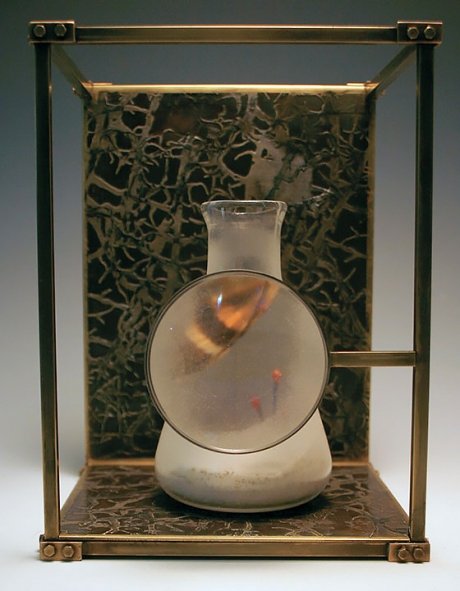Enter Reilly’s Matrix, Where Memory and Reality Collide
- News & Events
- News
- Enter Reilly’s Matrix, Where Memory and Reality Collide

“Have you ever had a dream, Neo, that you were so sure was real? What if you weren’t able to wake from that dream? How would you know the difference between the real world and the dream world?” — “The Matrix”
You may feel like you've just taken the red pill upon entering Dianne Reilly’s art exhibit. Held at Bannister Gallery, “Memento Vestige” is an exhibit where reality, as we know it, disintegrates.

“I’ve always thought about internal landscapes and how we are able to understand the emotive part of our experience. That has been consistent throughout my work,” said Reilly, RIC professor of metalsmithing and jewelry making.
In her latest work, Reilly explores time and memory. Her interest is in how human beings perceive things and try to understand their world. For humans, “time is understood in a way that disregards the present and reinvents the past,” she said. Human beings are constantly projecting the past onto the present moment.
We’ve all had that experience, for example, of coming in contact with someone who triggers in us a past trauma. Suddenly the present moment doesn’t exist anymore. We’re back in the past, at the time of the trauma, and the person in front of us has become a projection of our past wound.
“Projection is a shared human experience,” said Reilly. “These involuntary emotions/reactions come up even when we’re not calling them. We project both our painful and pleasurable memories onto the present moment.” Though our bodies move through time, our minds stay bonded to the past no matter how fragmented our memory of the past has become. The objects Reilly creates are fragmented images that appear in a state of suspended animation, frozen moments in time.
Reilly’s work also exposes the unreliable nature of memory. Not only does consciousness blink continuously in and out of present time, consciousness “reinvents” the past. “Time affects memory,” said Reilly. “Memories are lost, redirected, reorganized.”
Reilly pulls from the library of images we all recognize, such as a butterfly wing or a corpuscle, and then places them in a space that disorients the viewer. You're drawn to the image because you recognize it, but the image is placed so out of context, or with other objects that are so out of context, that the brain struggles to make meaning.
If we cannot trust memory to tell us what is real and if present-moment reality consists of excursions into a reinvented past, perhaps it is science that can tell us what is real and give us a definitive answer to the meaning of our world. Perhpas not, said Reilly.
Much of Reilly’s imagery references science. Objects appear as specimens in test tubes, beakers or behind bubbled glass. The environments they are in have the sterility of a science lab or exist in a vacuum. Magnifying glasses are positioned in front of images, which force the viewer to lean in and “study” the object, which immediately creates distance between the viewer and the viewed.
“Science sees specimens; it observes and dissects. Science takes things apart and arranges them in a way that makes sense,” said Reilly. In attempting to dissect, examine and categorize phenomena, science reduces it to fragments, which, when isolated from context, can be detached from a more holistic understanding of what is being observed. Through the shifting lens of perception, science, too, can fall victim to fractional interpretations of reality.
Ultimately, in “Memento Vestige” everything we see or “think we see” and everything we know or “think we know” is called into question.
“Questioning is a good thing,” said Reilly. “Being okay with ‘I don’t know’ allows us to open our minds to the possibility that what we think we are observing might be something else.”
“It’s uncomfortable not knowing, but I think uncomfortable is good,” she said. “Even if for a short time we are questioning ourselves or what we are seeing or how we are thinking, it’s a good thing. That’s where change happens. It may be painful or uncomfortable, but it’s necessary for a person or a group to evolve and to benefit from the experience.”
The intensive work that went into this exhibit was funded by a faculty research grant through the Office of Sponsored Programs. Much of the pieces were originally created for a 2015 group exhibit at Brown University’s Cohen Gallery by artists and researchers dealing with cognitive degenerative diseases such as Alzheimer’s. Alzheimer’s brings into sharp relief vestiges of memory – memory that is disappearing or no longer existent.
“Memento Vestige” runs through Feb. 23. Gallery hours are Monday-Wednesday: noon-8 p.m.; Thursday: 1:30-8 p.m.; and Friday: noon-8 p.m.
